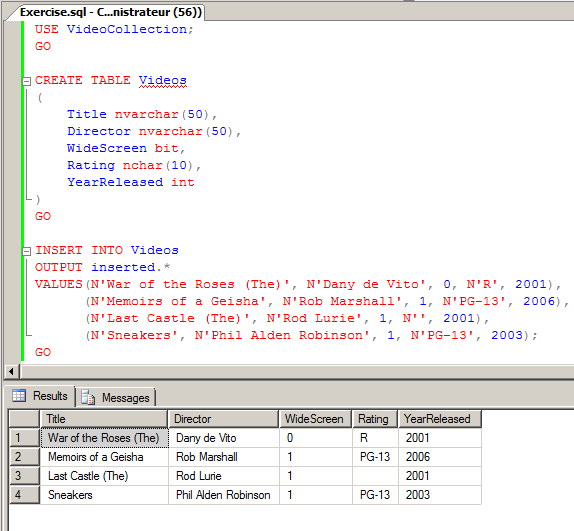|
|
After performing data entry on a table or a view, to
output the results in a separate table, you can use the OUTPUT
operator. The formula to follow is:
INSERT INTO TableName
OUTPUT INSERTED.Columns
VALUES(Value_1, Value_2, Value_X)
|
Here is an example:
USE VideoCollection;
GO
CREATE TABLE Videos
(
Title nvarchar(50),
Director nvarchar(50),
WideScreen bit,
Rating nchar(10),
YearReleased int
)
GO
INSERT INTO Videos
OUTPUT inserted.*
VALUES(N'War of the Roses (The)', N'Dany de Vito', 0, N'R', 2001),
(N'Memoirs of a Geisha', N'Rob Marshall', 1, N'PG-13', 2006),
(N'Last Castle (The)', N'Rod Lurie', 1, N'', 2001),
(N'Sneakers', N'Phil Alden Robinson', 1, N'PG-13', 2003);
GO
When this statement executes, if you are working in the
Microsoft SQL Server Management Studio, the lower part would display a list of
the records that were added:

If you want to store the list of newly created records in a
table, on the right side of the INSERTED operator and its period, type INTO
followed by the name of the table that will receive the values. Here is an example:
USE VideoCollection;
GO
CREATE TABLE Archives
(
Title nvarchar(50),
Director nvarchar(50),
WideScreen bit,
Rating nchar(10),
YearReleased int
)
GO
INSERT INTO Videos
OUTPUT inserted.* INTO Archives
VALUES(N'Two for the Money', N'D.J. Caruso', 1, N'R', 2006),
(N'Wall Street', N'Oliver Stone', 0, N'R', 2000);
GO
If you want to get the list
of newly inserted records, after the OUTPUT keyword, type INSERTED
followed by a period and followed by the name of the first column. The formula to use is:
INSERT INTO TableName(Column_1, Column_2, Column_X)
OUTPUT INSERTED.Column_1, INSERTED.Column_2, INSERTED.Column_X
VALUES(Value_1, Value_2, Value_X)
You can list the columns in an order of your
choice, as long as both the TableName and the OUTPUT section use
the exact same order. Here is an example:
USE VideoCollection;
GO
INSERT INTO Videos(Director, Rating, Title)
OUTPUT inserted.Director, inserted.Rating, inserted.Title
VALUES(N'Jonathan Lynn', N'R', N'Distinguished Gentleman (The)'),
(N'Paul Anderson', N'R', N'Soldier');
GO
When the statement has executed, the result
would display in the lower portion of the Microsoft SQL Server Management
Studio. If you want to store the result in a table, use the following formula
INSERT INTO TableName(Column_1, Column_2, Column_X)
OUTPUT INSERTED.Column_1, INSERTED.Column_2, INSERTED.Column_X INTO TargetTable
VALUES(Value_1, Value_2, Value_X)
Here is an example:
USE VideoCollection;
GO
CREATE TABLE Entertainment
(
Title nvarchar(50),
Director nvarchar(50)
)
GO
INSERT INTO Videos(Title, Director)
OUTPUT inserted.Title, inserted.Director INTO Entertainment
VALUES(N'Michael Jackson Live in Bucharest', N'Andy Morahan'),
(N'Outfoxed', N'Robert Greenwald');
GO